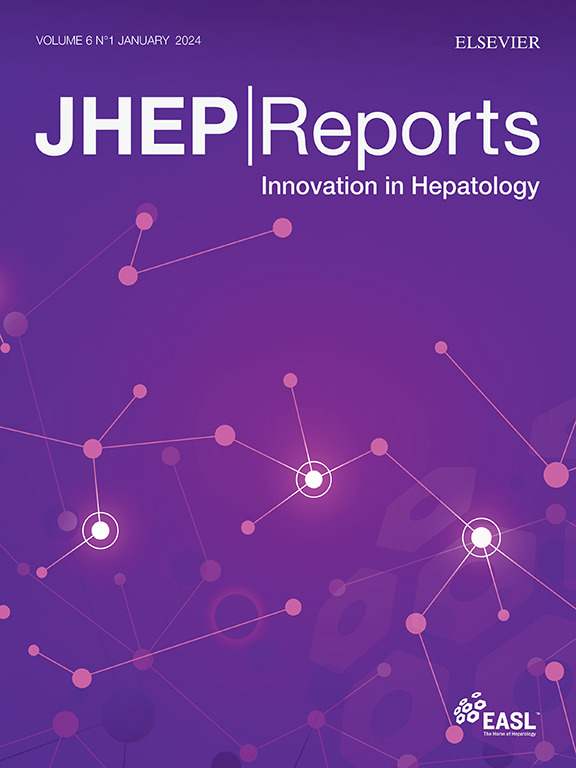基于人工智能的肿瘤浸润淋巴细胞评分系统评估肝切除术患者HCC预后
IF 9.5
1区 医学
Q1 GASTROENTEROLOGY & HEPATOLOGY
引用次数: 0
摘要
背景,肿瘤浸润淋巴细胞(til),特别是CD8+ til,是许多癌症的关键预后指标。然而,它们在肝细胞癌(HCC)中的预后价值仍然存在争议,证据不一。考虑到肝切除术HCC患者预后的异质性,本研究旨在开发一种基于人工智能的系统来量化CD8+ TILs并评估其对HCC患者的预后价值。方法:我们对接受肝切除术的患者进行了一项回顾性多中心研究,分为三个队列(N = 514)。我们训练了一个深度神经网络和一个随机森林模型来分割肿瘤区域,并在H&;E和CD8染色的全片图像中定位CD8+ til。我们量化了CD8+ TIL密度,并建立了CD8+肿瘤浸润性淋巴细胞自动评分(Automated CD8+ tumor -浸润性淋巴细胞评分,ATLS-8)系统来评估其预后价值。结果在发现队列中,低评分组5年总生存率为34.05%,高评分组为65.03%(风险比[HR] 2.40;95% ci, 1.37-4.19;P = 0.015)。这些发现在验证队列1中得到证实,验证队列1的5年OS率分别为28.57%和68.73% (HR 3.38;95% ci, 1.27-9.02;p = 0.0098),验证队列2分别为59.26%和81.48% (HR 2.74;95% ci, 1.05-7.15;P = 0.031)。atlas -8改进了基于临床变量的预后模型(C-index 0.770 vs. 0.757;0.769 vs. 0.727;0.712 vs. 0.642(三个队列)。结论:我们开发了一种使用cd8染色全片图像评估免疫浸润(atlas -8)的自动化系统。在接受切除术的HCC患者中,根据atlas -8评估,更高的CD8+ TIL密度与更好的OS相关。该系统是促进临床免疫微环境评估和预后预测的一个有前途的工具。影响和启示:CD8+肿瘤浸润淋巴细胞(til)已被确定为与许多癌症相关的预后因素。在这项研究中,CD8+ TILs被确定为肝切除的肝细胞癌患者总生存的独立预后因素。因此,基于全切片图像水平CD8+ TILs的新型数字生物标志物atlas -8可在HCC患者的预后评估中发挥重要作用,并可整合到临床病理模型中,参与患者的决策和预后评估。结合人工智能的评分系统对TILs的自动化、定量、全幻灯片图像水平评估至关重要,可广泛应用于多肿瘤疾病类型的免疫谱量化,并讨论后续的免疫治疗。本文章由计算机程序翻译,如有差异,请以英文原文为准。

AI-based tumor-infiltrating lymphocyte scoring system for assessing HCC prognosis in patients undergoing liver resection
Background & Aims
Tumor-infiltrating lymphocytes (TILs), particularly CD8+ TILs, are key prognostic markers in many cancers. However, their prognostic value in hepatocellular carcinoma (HCC) remains controversial, with different evidence. Given the heterogeneous outcomes in patients with HCC undergoing liver resection, this study aims to develop an AI-based system to quantify CD8+ TILs and assess their prognostic value for patients with HCC.
Methods
We conducted a retrospective multicenter study on patients undergoing liver resection across three cohorts (N = 514). We trained a deep neural network and a random forest model to segment tumor regions and locate CD8+ TILs in H&E and CD8-stained whole-slide images. We quantified CD8+ TIL density and established an Automated CD8+ Tumor-infiltrating Lymphocyte Scoring (ATLS-8) system to assess its prognostic value.
Results
In the discovery cohort, the 5-year overall survival (OS) rates were 34.05% for ATLS-8 low-score and 65.03% for ATLS-8 high-score groups (hazard ratio [HR] 2.40; 95% CI, 1.37–4.19; p = 0.015). These findings were confirmed in validation cohort 1, which had 5-year OS rates of 28.57% and 68.73% (HR 3.38; 95% CI, 1.27–9.02; p = 0.0098), and validation cohort 2, which had 59.26% and 81.48% (HR 2.74; 95% CI, 1.05–7.15; p = 0.031). ATLS-8 improved the prognostic model based on clinical variables (C-index 0.770 vs. 0.757; 0.769 vs. 0.727; 0.712 vs. 0.642 in three cohorts).
Conclusions
We developed an automated system using CD8-stained whole-slide images to assess immune infiltration (ATLS-8). In patients with HCC undergoing resection, higher CD8+ TIL density correlates with better OS, as per ATLS-8 assessment. This system is a promising tool for advancing clinical immune microenvironment assessment and outcome prediction.
Impact and implications:
CD8+ tumor-infiltrating lymphocytes (TILs) have been identified as a prognostic factor associated with many cancers. In this study, CD8+ TILs were identified as an independent prognostic factor for overall survival in patients with hepatocellular carcinoma who undergoing liver resection. Therefore, ATLS-8, a novel digital biomarker based on whole-slide image-level CD8+ TILs, could play an important role in the prognostic assessment of patients with HCC and could be integrated into clinicopathological models to participate in the decision-making and prognostic assessment of patients. The scoring system combined with artificial intelligence is essential for automated, quantitative, whole-slide image-level assessment of TILs, which can be widely applied to quantify the immune profile of multi-cancer disease types with the discussion of subsequent immunotherapy.
求助全文
通过发布文献求助,成功后即可免费获取论文全文。
去求助
来源期刊

JHEP Reports
GASTROENTEROLOGY & HEPATOLOGY-
CiteScore
12.40
自引率
2.40%
发文量
161
审稿时长
36 days
期刊介绍:
JHEP Reports is an open access journal that is affiliated with the European Association for the Study of the Liver (EASL). It serves as a companion journal to the highly respected Journal of Hepatology.
The primary objective of JHEP Reports is to publish original papers and reviews that contribute to the advancement of knowledge in the field of liver diseases. The journal covers a wide range of topics, including basic, translational, and clinical research. It also focuses on global issues in hepatology, with particular emphasis on areas such as clinical trials, novel diagnostics, precision medicine and therapeutics, cancer research, cellular and molecular studies, artificial intelligence, microbiome research, epidemiology, and cutting-edge technologies.
In summary, JHEP Reports is dedicated to promoting scientific discoveries and innovations in liver diseases through the publication of high-quality research papers and reviews covering various aspects of hepatology.
 求助内容:
求助内容: 应助结果提醒方式:
应助结果提醒方式:


